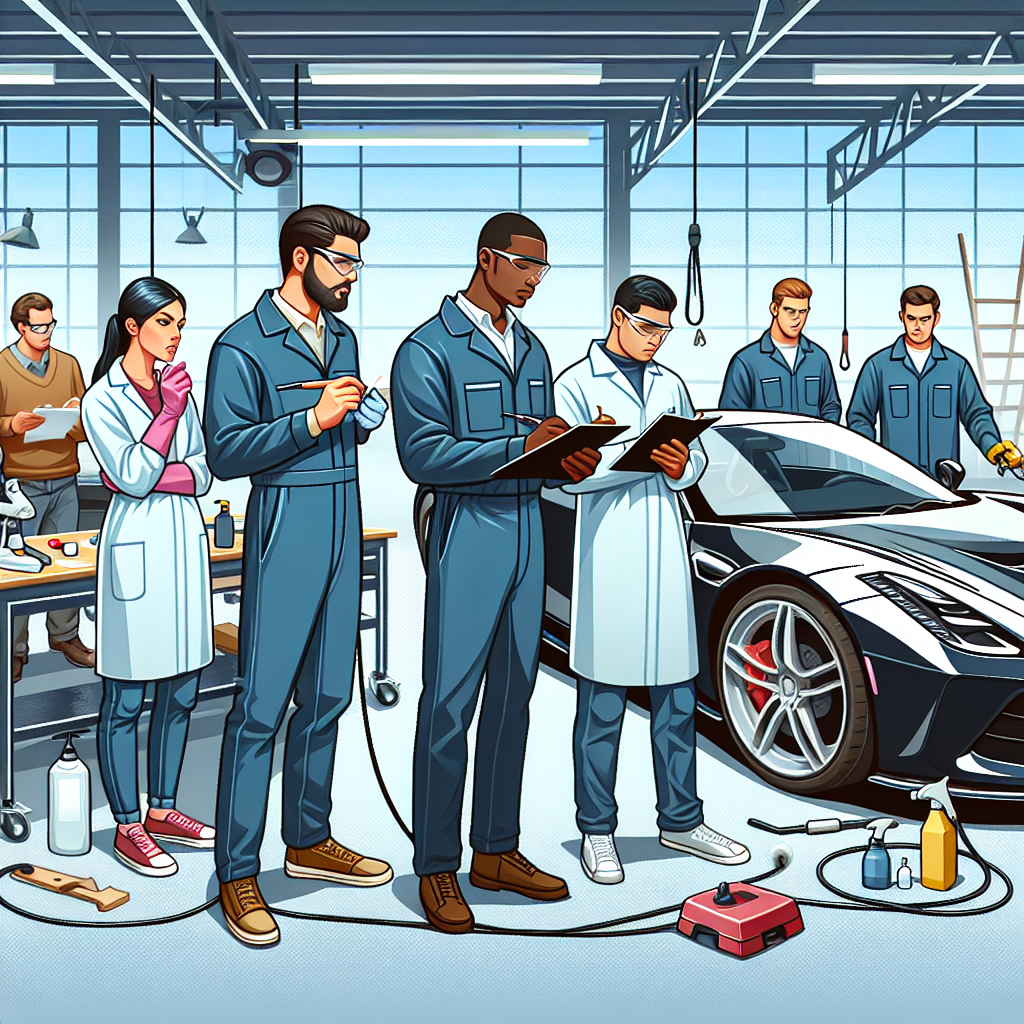Hands-on Practical Training
Understanding the Tools of the Trade
When it comes to auto detailing, knowing your tools can take you a long way. I remember my first day on the job, overwhelmed by the plethora of equipment around me. We’ve got polishers, buffers, vacuums, and all sorts of brushes—it’s essential to get familiar with all of it. A solid training program should start with hands-on experience, letting your team members take the tools for a spin.
In our training sessions, I emphasize that understanding each tool’s function and capability can lead to better efficiency. For instance, knowing the right buffer to use can protect the paint on a vehicle while enhancing its shine. Create opportunities for team members to practice using different tools on various vehicles, giving them confidence in their skills.
Ultimately, a good grasp of tools helps the detailers not just to become better but also to avoid common mistakes that can cost time and money. Trust me, nothing beats the feeling of a job well done when you know you’ve used the right tools in the right ways!
Real-World Application
Theoretical knowledge is great, but real-world application is where the magic happens. In my experience, I’ve found that the best way to reinforce learning is through practical scenarios. By staging different detailing challenges, your team can face problems head-on, think on their feet, and develop practical solutions on the fly.
For instance, we might set up a station where detailers have to clean different types of stains—think coffee spills, mud from off-roading, or pet hair. This not only enhances their problem-solving skills but also gives them a true sense of achievement when they see the before and after. Plus, these challenges bring a lighter atmosphere to training sessions, which I personally feel makes learning fun!
Always encourage feedback during these sessions. After each challenge, hosting a discussion allows team members to share what they learned and provide tips based on their experiences. This collaborative environment fosters growth and helps everyone sharpen their skills together.
Emphasis on Safety Protocols
One of the most crucial parts of any training program is safety. Working in auto detailing involves chemicals, tools, and sometimes high-residue jobs that can pose risks. From my own mishaps early on, I’ve learned that ignoring safety can lead to injuries and costly accidents. Therefore, it’s super important to weave safety protocols into every aspect of your training.
In our training, we spend a good chunk of time discussing and practicing safety measures. Everyone should know how to handle chemicals carefully and understand the importance of wearing personal protective equipment (PPE) like gloves and masks. Regular safety drills keep these practices fresh in everyone’s mind.
Creating a safety-first mentality not only protects your team but also enhances the quality of work being done. A safe environment boosts morale and effectiveness, and honestly, no one wants to be worried about getting hurt while doing a job they love!
Customer Interaction Skills
Building Rapport with Clients
One thing that’s vital in the auto detailing business is client interaction. Over the years, I’ve seen how a friendly attitude can open doors. A Training program should focus on developing these soft skills, teaching team members how to engage with clients effectively.
Setting scenarios where detailers practice greeting clients, understanding their needs, and offering solutions is so important. The more comfortable they are talking to different personalities, the better service they can provide. At one session, we even created role-playing activities just for this use; they brought lots of laughter and learning!
Also, encourage them to listen. By genuinely hearing a client’s concerns or wishes, detailers can tailor their services better and create repeat customers who will recommend their service. Trust me, a happy customer who feels valued is the best kind of advertisement.
Handling Complaints Gracefully
No matter how good you and your team are, complaints will happen. In my years, I’ve faced my share of upset clients. A critical part of the training should prepare team members to handle complaints gracefully and turn negativity into an opportunity. It’s all about perspective, right?
Teach your team that every complaint is a chance to improve. Role-playing can be particularly effective here. Simulating situations where a client is dissatisfied gives them practice in responding calmly, understanding the issue, and finding a solution that works for everyone.
The more comfortable they feel handling tough situations, the more confidence they’ll have in their skills and customer relations. I swear, I’ve seen detailers turn upset clients into satisfied customers just by showing a little empathy and a willingness to rectify issues!
Effective Communication
Lastly, communication isn’t just about talking but also about conveying information effectively. I often stress to my team how important it is to communicate clearly with clients and within the team. During our training, we tackle the nuances of communication, from explaining services to clients, to making sure instructions are understood among team members.
Practice helps! By exchanging feedback and discussing service options as a group, we develop a shared understanding. Plus, this approach enables team members to feel comfortable asking questions if unsure about tasks or procedures.
The goal here is to create an environment where everyone feels supported and informed. Good communication leads to better services and an enjoyable workplace—trust me; that’s what keeps everyone happy and coming back for more!
Product Knowledge Enhancement
Understanding Different Products
A solid understanding of the products you use can set your team apart. Invest time in educating your team members about different types of coatings, waxes, sealants, and cleaners. When they know what products to use for what job, the results speak for themselves.
I’ve found that while sometimes price can be a factor, the quality of the product often shines through in the detailing results. Spend some time comparing products, diving into the pros and cons of each, and what types of vehicles they’re best suited for. Doing hands-on product comparisons can enhance their understanding immensely.
Additionally, invite product representatives or experts to share insights and practical demonstrations. This gives your team direct exposure to the latest and greatest in the industry! Remember, a knowledgeable team is a confident team.
Eco-Friendly Practices
In today’s environment-conscious world, incorporating eco-friendly practices should be a part of your training program. I’ve heard from clients time and again how important it is for them to know their detailing service cares about the environment. Teach your team about sustainable products and practices, discussing how they can reduce their ecological footprint.
Encouraging the use of biodegradable products and water-saving techniques not only benefits our planet but also appeals to a broader customer base. Customers appreciate knowing they are making eco-friendly choices by opting for your services. The training should include the practical application of these products to ensure the team can comfortably use them.
Fostering an eco-friendly mindset helps instill pride in the services you offer while preparing your team for a future where sustainability is not just a trend but a necessity.
Staying Updated with Trends
The auto detailing world is always evolving. Whether it’s new products, techniques, or customer expectations, staying updated is key. Make sure to incorporate continuous learning and adapting into your training program. This way, when something fresh hits the market, your team is the first to know!
Set up a system where team members can share articles, attend workshops, or follow industry leaders. Regularly scheduled meetings to discuss trends can encourage team members to contribute updates. Sharing knowledge and ideas can generate excitement and creativity for upcoming tasks.
Ultimately, a well-informed team is directly linked to customer satisfaction and business growth. Keep those learning wheels turning and watch your detailing service thrive!
Performance Evaluation and Feedback
Setting Clear Performance Goals
When it comes to improving skills, setting clear performance goals is essential. I’ve learned that without specific targets, progress can feel stagnant. In your training program, make sure to establish tangible, quantifiable goals. These may include speed, attention to detail, or customer satisfaction rates.
By defining these targets, everyone has something concrete to aim for. You can check progress periodically, fostering a culture of growth. If someone is hitting their targets, celebrate! If not, work together to identify obstacles and paths for improvement.
With these clear expectations, your team can view their growth as more than just improvement—it becomes a friendly competition that fuels motivation and engagement!
Constructive Feedback Loops
Feedback is an art; I’ve learned it should be both constructive and encouraging. Making it a prominent part of your training can help team members truly grow. Why? Because nobody is perfect, right? I always target a balance between what’s going well and areas for improvement.
In our training sessions, I encourage team members to embrace feedback as a tool for development rather than criticism. After completing training modules or working through practical tasks, we gather to discuss what was learned. This open dialogue means they can leave feeling motivated to meet new challenges—together.
Using peer reviews allows for collaboration and builds a strong team dynamic. Everyone has unique insights, so why not utilize that? You’ll find that sharing perspectives can lighten the mood and lead to newfound appreciation for each other’s skills.
Regular Evaluations and Adjustments
Finally, it’s crucial to implement regular evaluations. Creeping complacency can plague even the best teams. I strongly believe in periodically checking in on skills and knowledge. Set reviews every few months to reflect on progress made towards those defined performance goals and to keep things fresh.
During evaluations, take the time to analyze the outcomes of the training sessions and ask for feedback from participants about what worked and what didn’t. This process is invaluable; it not just enhances the training program but also empowers the team by involving them in the decision-making chain.
By continuously adjusting your training methods based on feedback and performance outcomes, you keep the program dynamic and focused on achieving excellence. The auto detailing world is ever-changing, and it’s crucial that your training reflects that reality!
FAQ
1. What are the key areas of focus in an auto detailing training program?
The key areas include hands-on practical training, customer interaction skills, product knowledge enhancement, and performance evaluation and feedback. Each aspect helps team members develop the skills necessary for successful detailing work.
2. How can I make practical training effective?
Integrating real-world applications, conducting hands-on practice with tools, and setting up scenarios that mimic common detailing challenges can make practical training effective. Regular feedback after these exercises is also essential.
3. Why is customer interaction training important?
Customer interaction training is vital because it helps build rapport with clients and addresses complaints effectively. Satisfied customers are more likely to return and refer others, enriching your business’s reputation.
4. How can a team stay updated on industry trends?
Encourage team members to engage in continual learning through workshops, webinars, and by following industry leaders. Sharing articles and updates during team meetings can also keep everyone informed about new products and techniques.
5. What role does feedback play in skill enhancement?
Feedback plays a crucial role in skill enhancement as it helps identify strengths and areas for improvement. Establishing a culture of constructive feedback can foster growth, motivate team members, and ensure consistent performance improvements.



